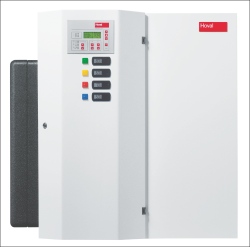Optimising district heating

As district heating increases in popularity it is important to pay close attention to every aspect of the system design if optimum performance is to be achieved. Geoff Lord of Hoval explains.
While district heating may have had something of a chequered history in the UK in the past, the last few years have seen a considerable resurgence in its popularity. Indeed, district heating is set to play a key role in the UK’s carbon-reduction strategy and is also central to the European heating and cooling plan. The UK Government is also making funding available to help local authorities explore the feasibility of district-heating systems in their areas.
Nevertheless, in recent months mixed opinions have been expressed within the building-services industry regarding the overall efficiency of district heating. When the situation is examined carefully, however, it is clear that where district-heating systems have delivered disappointing performance in the past this has usually been the result of non-optimal system design.
The key point here is that achieving optimum efficiency requires a whole-system approach. Specifying plant that is inherently efficient is certainly one part of the equation, but the rest of the system needs to be designed to exploit that inherent efficiency. In most cases this will also involve integrating different heating technologies and ensuring they work in harmony. Beyond the plant room, as is made clear in the CIBSE/ADE (Association for Decentralised Energy) ‘Heat networks code of practice’, the management of hot-water flow rates and flow and return temperatures is also critical.
Most district-heating systems that are currently being installed are serving single multi-occupancy buildings or relatively small groups of buildings from a central plant room. As smaller combined heat and power (CHP) plant becomes available, many of these schemes take advantage of the ability to generate both heat and electricity. In addition, the CHP may be backed up by other heat sources that can include biomass boilers, gas- or oil-fired boilers, heat pumps and solar thermal.
In the case of individual multi-occupancy buildings, space heating and domestic hot water are typically controlled, and possibly metered, by heat interface units (HIUs) within each of the spaces. This is relatively straightforward as the temperatures and pressures will be consistent throughout the building, and well-designed HIUs can adjust to variable demand from different spaces.
Where more than one building is involved there can be considerable variation between the temperatures and pressures required by each building. This is especially the case with schemes that incorporate a number of different building types — an approach that is generally desirable because mixed demand patterns spread heat loads more evenly.
In such cases, each building needs to be fitted with a sub-station that is capable of converting the hot-water temperatures and pressures provided by the energy centre to the operating conditions required by the building. Each sub-station will typically comprise a plate heat exchanger, pumps and heat meters — ideally in a compact packaged configuration to minimise plant-room space requirements.

In the energy centre itself it is essential that the various types of heating plant are controlled to take advantage of the performance characteristics of each. For example, the CHP unit could be sized on its thermal output to achieve a constant base load throughout the year, with the power generated being used onsite, exported to the grid or both. Then a biomass boiler could also be added to accommodate the increased base load as heating systems are switched on during colder periods.
However, it is also important to make provision for peak loads with heat sources that are highly responsive and efficient at variable heating loads while maintaining constant flow temperatures. An obvious solution is to incorporate fully modulating gas or oil boilers.
If the energy centre is also producing domestic hot water, then minimum-storage high-output calorifiers or plate heat exchangers feeding into stainless-steel buffer vessels should be considered, potentially pre-heated by solar thermal or heat pumps.
Clearly, with such a diverse mix of heat sources the controls will play a major role in preventing conflicts between the different types of plant. It is therefore important to specify controls that are capable of managing single or multiple conventional and low-carbon heat sources, with functionality such as real-time monitoring and visualisation.
The important thing is that with any district-heating system served by a multi-source energy centre, it is essential to ensure that all the systems work efficiently together and that hot-water temperatures and pressures are properly controlled at each building. An holistic approach to system design and the use of compatible components within the system is the way to deliver the best solution for the end client.
Geoff Lord is national technical sales manager with Hoval.








